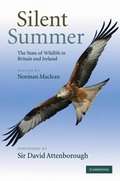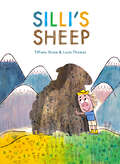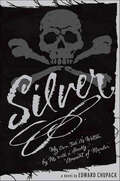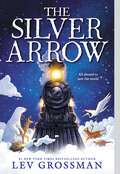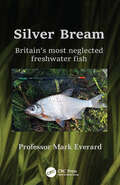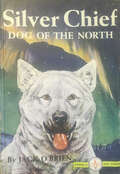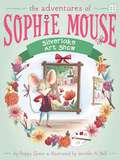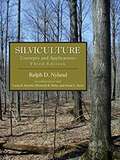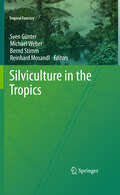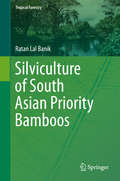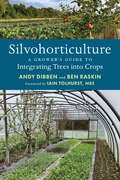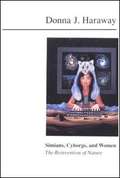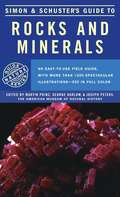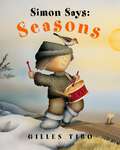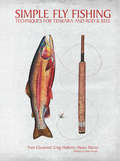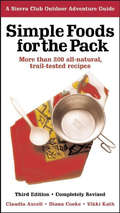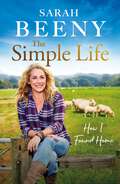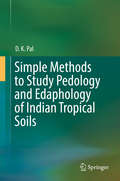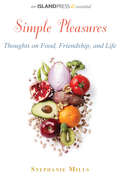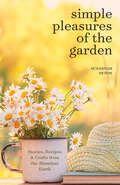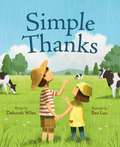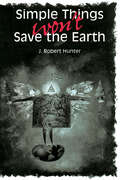- Table View
- List View
Silent Summer
by Norman MacleanOver the past 20 years dramatic declines have taken place in UK insect populations. Eventually, such declines must have knock-on effects for other animals, especially high profile groups such as birds and mammals. This authoritative, yet accessible account details the current state of the wildlife in Britain and Ireland and offers an insight into the outlook for the future. Written by a team of the country's leading experts, it appraises the changes that have occurred in a wide range of wildlife species and their habitats and outlines urgent priorities for conservation. It includes chapters on each of the vertebrate and major invertebrate groups, with the insects covered in particular depth. Also considered are the factors that drive environmental change and the contribution at local and government level to national and international wildlife conservation. Essential reading for anyone who is interested in, and concerned about, UK wildlife.
Silkies and Other Guinea Pigs (World Book's Animals of the World)
by Dan BlunkTopics include: different kinds of guinea pigs, how they are cared for and shown, and where they came from.
Silli's Sheep
by Tiffany Stone Louis ThomasFor fans of Sophie's Squash and other super-silly picture books, here is the endearing story of a man named Silli who tries to tame the wind in ridiculous ways.Silli lives in the middle of a meadow, in the open air. One morning, a gust of wind pays a visit--brrrr! What if the wind comes to stay? If only Silli could find some sheep, he'd have wool to knit a sweater to keep him warm. Luckily, he spots five large "sheep" up on a hill--perfect! It's just too bad they're resistant to herding and their wool is incredibly hard. But when Silli leans against them, they block the wind and keep him warm. . . . Perhaps he can build a shelter made of sheep? And so he resourcefully arranges his sturdy sheep (which are actually sheep-shaped rocks) into a little hut, and is finally warm and dry. This charming story--crafted in the tradition of folkloric characters who are well-meaning, likeable, and also a bit ridiculous--is sure to have a ton of kid appeal.
Silver: My Own Tale As Written by Me with a Goodly Amount of Murder
by Edward ChupackI am Silver, and there is no other pirate like me on these waters.This being the last testament of the infamous pirate Long John Silver, you would do well not to trust a word in its pages. Held captive aboard his own ship, the Linda Maria, he is to be taken to England, where he will hang at the king's pleasure. But he has another plan: to tell a tale of treason, murder, a lost treasure that would rival King George's own riches, and what really happened on Treasure Island . . . if Long John Silver is to be believed. But is he?His beginnings as a pickpocket on the streets of Bristol are as dark as the rest of his deliciously devious life. Taken to sea by the pirate captain Black John, Silver soon learns the arts of his trade: the sword, saber, and pistol. He makes his trade in plundering, cheating, ransacking, and murder---more murders than he can bother to count. British, Frenchmen, Spaniards, and Portuguese all fall before him. He takes exceptional pleasure in murder, but never such pleasure as he finds in his search for a most uncommon treasure. To find that treasure he must heed the words of a dead man, solve the ciphers in a well-worn Bible, forgo the love of an extraordinary woman, and climb over the corpses of friend and foe alike to arrive at Treasure Island and find his fortune.But Silver's tricks are never done. Before he greets the hangman at Newgate Square, he will have one last secret to reveal. Hidden in these pages are clues that lead to his remarkable discovery. And although King George's bounty for this notorious scourge may be handsome indeed, the captain who has captured Silver would not mind adding Silver's riches to his own purse. He will let Silver tell his tale in the hope of learning clues to the treasure's location. And if you were to mark his words as well, you might discover the whereabouts of that treasure yourself. So we shall, for now, allow Long John Silver to spin his stories, tales of adventure and betrayal, gold and jewels, love and murder.And he will never leave out the murder. Not Long John Silver.
The Silver Arrow
by Lev GrossmanDear Uncle Herbert, You've never met me, but I'm your niece Kate, and since it is my birthday tomorrow and you are super-rich could you please send me a present? <p><p> Kate and her younger brother Tom lead dull, uninteresting lives. And if their dull, uninteresting parents are anything to go by, they don't have much to look forward to. Why can't Kate have thrilling adventures and save the world the way people do in books? Even her 11th birthday is shaping up to be mundane -- that is, until her mysterious and highly irresponsible Uncle Herbert, whom she's never even met before, surprises her with the most unexpected, exhilarating, inappropriate birthday present of all time: a colossal steam locomotive called the Silver Arrow. <p> Kate and Tom's parents want to send it right back where it came from. But Kate and Tom have other ideas -- and so does the Silver Arrow -- and soon they're off to distant lands along magical rail lines in the company of an assortment of exotic animals who, it turns out, can talk. With only curiosity, excitement, their own resourcefulness and the thrill of the unknown to guide them, Kate and Tom are on the adventure of a lifetime . . . and who knows? They just might end up saving the world after all. <p> This thrilling fantasy adventure will not only entertain young readers but inspire them to see the beautiful, exciting, and precious world around them with new eyes. <p> <b>A New York Times Bestseller</b>
Silver Bream: Britain’s most neglected freshwater fish
by Mark EverardThis book is dedicated to the Silver Bream, a fish too long neglected by anglers, wildlife enthusiasts and science. In fact, this is the first book ever devoted to this freshwater fish. Scientist, author and broadcaster Dr Mark Everard introduces the biology of the silver bream, angling for this fish, and its diverse social quirks and values.
Silver Brumbies of the South (Silver Brumby #3)
by Elyne MitchellThowra, the most beautiful brumby stallion ever to gallop across the great Main Range, is disturbed by men bringing machinery and noise to the area of the mountains which he roams. Storm also has been uneasy and has taken his mares and sons further south. When they meet they decide to take the restless young stallions, Lightning and Baringa, further to the south where they will have to fight for a place with the herds already there. Lightning and Baringa become competitors, with Lightning always trying to steal Baringa's mares. Baringa saves Lightning three times but each time he knows: he will have to fight Lightning again next spring.
Silver Chief: Dog of the North (Famous Dog Stories and Silver Chief #1)
by Jack O'BrienSilver Chief is the son of a Husky whose father was a wolf. After his mother is killed he hates all mankind until a Canadian Mountie shows him kindness.
Silverlake Art Show (The Adventures of Sophie Mouse #13)
by Poppy GreenIn this thirteenth charming book of The Adventures of Sophie Mouse series, Sophie hosts the very first Silverlake Art Show!Sophie has a brilliant idea: she&’s going to host the very first Silverlake Art Show! After all, she loves to draw and paint and she likes looking at art too. With the help of Hattie Frog and Owen Snake, Sophie puts together the whole event. And when the big night comes, she expects to be the star of the show. But she gets a surprise when she realizes…she&’s not! Who is this mystery artist that everyone is chirping and buzzing about? With easy-to-read language and illustrations on almost every page, the Adventures of Sophie Mouse chapter books are perfect for beginning readers.
Silviculture: Concepts And Applications
by Ralph D. NylandSilviculture: Concepts and Applications reflects a belief that all the tools of silviculture have a useful role in modern forestry. Through careful analysis and creative planning, foresters can address a wide array of commodity and nonmarket interests and opportunities while maintaining dynamic and resilient forests. A landowner's needs, circumstances, and site conditions guide a silviculturist's judgment and decision making in finding the best ways to integrate the biologic-ecologic, economic-financial, and managerial-administrative requirements at hand. The Third Edition of this influential text provides a foundational basis for rigorous discussion of techniques. The inclusion of numerous real-world examples and balanced coverage of past and current practices broadens the concept of silviculture and the ways that managers can use it to address both traditional and emerging interests in forests. A thorough discussion of new and proven interpretations increasingly directs the attention of foresters toward the role silviculture plays in creating, maintaining, rehabilitating, and restoring forests that can sustain an expanding variety of ecosystem services.
Silviculture in the Tropics
by Bernd Stimm Reinhard Mosandl Michael Weber Sven GünterThis book integrates the latest global developments in forestry science and practice and their relevance for the sustainable management of tropical forests. The influence of social dimensions on the development of silvicultural concepts is another spotlight. Ecology and silvicultural options form all tropical continents, and forest formations from dry to moist forests and from lowland to mountain forests are covered. Review chapters which guide readers through this complex subject integrate numerous illustrative and quantitative case studies by experts from all over the world. On the basis of a cross-sectional evaluation of the case studies presented, the authors put forward possible silvicultural contributions towards sustainability in a changing world. The book is addressed to a broad readership from forestry and environmental disciplines.
Silviculture of South Asian Priority Bamboos
by Ratan Lal BanikThis monographaims at bringing out a comprehensive collection of information on bamboovarieties in South Asia. The main focus of this book is to address theecological and economic significance of bamboos. Bamboo is a versatile group of plants, capable of providing ecological,economic and livelihood security to the people. In the tropics, especially therural areas in different countries of South Asia, most of the houses aremade of bamboos. In the hilly areas of Bangladesh, Bhutan, Nepal and India, thetribal people take bamboo shoots as one of their major food items sinceprehistoric days. With palatableshoots and grass like leaves bamboo plants have also been liked by many herbivore animals, such as, elephants,the wild cattle, Indian Bison, and some speciesof deer. The red-panda in the Himalayas, and primates,pigs, rats and mice, porcupines, and squirrels are also incidental feeders onsoutheast Asian bamboos. There has been a growing awareness in recent years about the values ofbamboo being an important means of economic growth and for improving thesocio-economic conditions of the rural poor. Bamboo as an industrialmaterial can substitute wood and that to at low cost. Due to increasing demandand squeezing of bamboo area the plants have been overexploited and the qualityand quantity of resource alarmingly getting depleted. Besides many new bamboobased industries have come up which also urgently require uninterrupted supplyof species wise bamboo resource. The south Asia region has bestowed with more than 300 bamboospecies with enormous diversities at species, ecological and geneticallevel. A number of bamboo species are found common among countriesof the region selected for various utilization potentials having wide range of ability to adjustenvironmental conditions of these countries and thus prioritized forcultivation. Both government and private planters in the region have started allocating funds, land andother logistics to raise large scale plantation of desired bamboospecies. This book has been drafted to find out answers of the most pertinentqueries based on the field observations on each of the bamboo species andknowledge learnt from the indigenous people living with bamboos in differentparts of south-east and south Asian countries. This monograph would beinteresting and useful to bamboo professionals, foresters, horticulturists,field level extension workers, nurserymen, planters, industrial entrepreneurs,ecologists, and valuable source of reference to the relevant researchers andstudents in the region.
Silvohorticulture: A grower's guide to integrating trees into crops
by Andy Dibben Ben Raskin"Dibben and Raskin offer an insightful, inspiring but also exceptionally practical guide to integrating trees into annual cropping systems. . . in this book we see how the phrase 'the sky’s the limit' has never been more applicable."—Jesse Frost, author of The Living Soil Handbook An invaluable handbook for farmers, growers, and gardeners, Silvohorticulture is the first book to offer a detailed, practical guide on how to effectively integrate trees with vegetable growing, offering information previously known only in the foresting world. Drawing on the decades-long experiences of Ben Raskin and Andy Dibben, both of whom have designed and managed agroforestry systems and have extensive experience in commercial horticultural crop production, this is the definitive book on the interaction between trees and crops, covering the benefits of trees for edible crops and the potential for additional crops from trees, plus crucial new information on how to fit trees into complex crop rotations as well as manipulating access to light. Ben and Andy also reveal the latest research on how tree roots behave and, importantly, how that impacts your crops. Agroforestry can bring immense benefits to farmers and growers—not just optimizing yield, but also improving soil, managing pests and water, increasing biodiversity, and reducing costs. System design must be customised to each grower’s requirements, and Silvohorticulture offers step-by-step detail that will allow you to manage your trees and crops successfully. "In this immensely practical guide, the authors provide the technical details towards integrating trees with vegetables and other crops, all while dispelling any preconceived notions that this idea reduces productivity or function. In fact, these systems might prove essential for farm resilience in a changing climate."—Steve Gabriel, author of Silvopasture
Simians, Cyborgs, and Women: The Reinvention of Nature
by Donna J. HarawayA collection of ten essays written mostly during the eighties. With a feminist perspective and the premise that nature is constructed, rather than discovered-- and that truth is made, not found-- Haraway provides an analysis of the popular and scientific struggles involved in the telling of evolutionary tales. The author is a historian of science at the U. of California, Santa Cruz.
Simon and Schuster's Guide to Rocks and Minerals
by Martin Prinz George Harlow Joseph Peters Annibale Mottana Rodolfo Crespi Giuseppe Liborio Simon Schuster StaffAn easy to use field guide that contains everything rock and mineral enthusiasts need to know with more than 1,000 spectacular illustrations--600 in full color! Practical, concise, and easy to use, Simon & Schuster's Guide to Rocks and Minerals contains everything that the rock and mineral enthusiast needs to know. This field guide is divided into two large sections--one devoted to minerals and one to rocks, each prefaced by a comprehensive introduction that discusses formation, chemistry, and more. All 377 entries, beautifully illustrated with color photographs and helpful visual symbols, provide descriptions and practical information about appearance, classification, rarity, crystal formation, mode of occurrence, gravity of mineral, rock chemistry, modal classification fields, formational environments, grain sizes of rocks, and much more. Whether you are a serious collector or an information-seeking amateur, this incomparably beautiful, authoritative guide will prove an invaluable reference.
Simon Says: Seasons (Simon)
by Gilles TiboMeet Simon, a little boy with big dreams. His imagination leads him to all kinds of wonderful adventures. With the help of his friend, Marlene, and with his own special spirit, Simon makes each season a memorable one.Simon welcomes spring — As the snow begins to melt, Simon decides he will hurry spring’s arrival. When his drum fails to call it forth, he tries fantastic but charmingly imaginative ways to pull flowers from the earth, tempt birds to return, and encourage bears to awaken — only to discover that spring will come in its own time, despite what we try to do to make it come any sooner.Simon in summer — Simon loves summer so much that he never wants it to end. When he sees the first signs of fall, he seeks advice from a heron and a cow, who tell him how to make summer last. Simon tries by making the frogs sing, pleasing the butterflies with paper flowers, and keeping the sun high in the sky.Simon and the wind — Simon tries to use the wind to fly. As he blows bubbles into the breeze, he thinks he can make one large enough to carry him. His friend Marlene brings him a cardboard box, and Simon asks the birds to carry it like a plane across the sky. Finally, Simon learns he cannot fly, but discovers a game he and his friends can play with the wind.Simon and the snowflakes — Simon is curious. He wants to know how many snowflakes fall in a snowstorm, but they come down too fast to count. When he learns that there are as many snowflakes as stars in the sky, he tries to count them too, but they race across the night sky. Simon decides to visit his friends in the forest and finds something much better to count there.
Simple Acts to Save Our Planet: 500 Ways to Make a Difference (Simple Acts Gift Series)
by Michelle NeffSimple Acts to Save Our Planet shows you how to be more active in saving our planet every day by performing some &“Simple Acts of Kindness&”—for the Earth.Treat the environment with kindness with these easy, manageable activities that range from simple home updates, to gardening basics, to supporting the local community. You&’ll learn simple techniques to help protect the planet every day, like starting a compost pile to reduce food waste, utilizing travel mugs and reusable containers, and choosing eco-friendly products. By working to implement these simple strategies into your everyday life, you can take an active stand to protect the environment now— and make a real difference for the future.
Simple Fly Fishing
by Craig Mathews Mauro Mazzo Yvon Chouinard Russell Chatham James ProsekModern-day fly fishing, like much in life, has become exceedingly complex, with high-tech gear, a confusing array of flies and terminal tackle, accompanied by high-priced fishing guides. This book reveals that the best way to catch trout is simply, with a rod and a fly and not much else. The wisdom in this book comes from a simpler time, when the premise was: the more you know, the less you need. It teaches the reader how to discover where the fish are, at what depth, and what they are feeding on. Then it describes the techniques needed to present a fly at that depth, make it look lifelike, and hook the fish. With chapters on wet flies, nymphs, and dry flies, its authors employ both the tenkara rod as well as regular fly fishing gear to cover all the bases. Illustrated by renowned fish artist James Prosek, with inspiring photographs and stories throughout, Simple Fly Fishing reveals the secrets and the soul of this captivating sport.
Simple Foods for the Pack: More than 200 All-Natural, Trail-tested Recipes
by Claudia Axcell Bob Kinmont Diana Cooke Vikki Kinmont KathThis latest edition of the original--and best--natural foods backpacking cookbook features a wealth of new recipes and mouthwatering classics, as well as the most current information on cooking with today's lightweight foods and equipment. This unique cookbook brings together the expertise of culinary professionals and the wilderness knowledge of a former backcountry guide to provide more than 180 trail-tested recipes for delicious, natural, and easy-to-prepare meals for backpacking, hiking, and camping. Since Sierra Club Books published the first edition of Simple Foods for the Pack in 1976, there has been a revolution in backcountry cooking. Today's lightweight stoves and kitchen tools make cooking in the wild easier than ever before. And with the ubiquitous availability of fast-cooking natural foods, the modern adventurer has tasty alternatives to the expensive pre-packaged meals that are on the market.Focusing on these natural foods and the latest equipment, this newly revised edition offers hikers gourmet taste at every meal--from Oatmeal Hotcakes for breakfast, to homemade "nutrition bars" for the trail, to Beer Fondue back at camp. The wide variety of menus and the expanded guide to planning, packing, and preparing food make cooking in the backcountry as easy as High Mountain Pie.
The Simple Life: The unmissable memoir from one of Britain’s most loved presenters
by Sarah BeenyJoin Sarah Beeny on her journey to live more simply and find her forever home...Throughout her life, Sarah Beeny has been obsessed with the idea of home. From her childhood growing up in a countryside cottage to renovating her very first flat in London to restoring a stately home in Yorkshire, she has never been afraid of the hard work needed to turn a house into a home. Now, in her most recent adventure, Sarah and her family have moved to a former dairy farm in Somerset to build the home of their dreams. In The Simple Life, Sarah will tell the story of her life, sharing tales and experiences in everything including parenting, property, friendships, nature and the environment, all the way through to her recent cancer diagnosis and treatment. Through it all, Sarah tackles challenges and troubles with signature wit and wisdom, discovering life is never as 'simple' as you'd like it to be.
Simple Methods to Study Pedology and Edaphology of Indian Tropical Soils
by D. K. PalThis book discusses how research efforts have established an organic link between pedology and edaphology of five pedogenetically important soil orders as Alfisols, Mollisols, Ultisols, Vertisols and Inceptisols of tropical Indian environments. The book highlights how this new knowledge was gained when research efforts were complemented by high resolution mineralogical, micro morphological and age-control tools. This advancement in basic and fundamental knowledge on Indian tropical soils makes it possible to develop several index soil properties as simple methods to study their pedology and edaphology. More than one-third of the world’s soils are tropical soils. Thus the recent advances in developing simple and ingenuous methods to study pedology and edaphology of Indian tropical soils may also be adopted by both graduate students and young soil researchers to aid in the development of a national soil information system to enhance crop productivity and maintain soil health in the 21st century.
Simple Pleasures: Thoughts on Food, Friendship, and Life (Island Press E-ssentials)
by Stephanie MillsIn Simple Pleasures: Thoughts on Food, Friendship, and Life we have highlighted two chapters from Stephanie Mill's reflection the pleasures, as well as the virtues and difficulties, of a perhaps simpler than average North American life. It is a thoughtful paean to living, like Thoreau, a deliberate life. Mill's writing is beautifully crafted, fluid, inspiring, and enlightening, and these chapters encourage you to take a moment to reflecton your own life. It celebrates the pleasures, beauty, and fulfillment of a simple life, a goal well worth striving for.
Simple Pleasures of the Garden: Stories, Recipes & Crafts from the Abundant Earth (Simple Pleasures Ser.)
by Susannah SetonSimple Pleasures Throughout the Year “Simple Pleasures has become my go-to book for remembering to slow down and enjoy the little things in life.” —Becca Anderson, bestselling author of Badass Affirmations, The Book of Awesome Women, and moreAn abundant sourcebook of ideas, encouraging quotes, recipes, and soothing activitiesSimple Pleasures of the Garden shows you how to appreciate the simple things within your daily activities. The secret to living well year round can be found in the abundance of your home garden, so get to planting those seeds of simple joys and herbal healing! Nurture your mind, body, and soul. Sometimes finding the positive can be hard, but it doesn’t have to be. From the recipe for a homemade herbal bath for a spa day to quick and easy recommendations for an instant room makeover, the suggestions and home recipes collected in this book offer a new appreciation for the everyday activities that nurture and comfort you.Simplify your emotional self care. Taking care of yourself doesn’t have to be expensive, unrealistic, or inaccessible. It can be as easy as tending to a green garden, making healing herbal tonics, sipping calming teas, or spending time with other natural energy boosters. Pleasures are made, not bought, so unlock new secrets to happiness with these touching stories, practical tips, and satisfying crafts. Inside this positive attitude book you’ll find: Ways to decorate your home with nature crafts, growing herbs, and an air of magic Advice on how to foster a routine for a rejuvenating self care yearTips on how to become the gardener of your moods and emotionsIf you liked seasonal self care books like A Year of Self-Care, Grow Your Own Medicine, or A Woman’s Garden, you’ll love Simple Pleasures of the Garden.
Simple Thanks
by Deborah WilesFrom award-winning author Deborah Wiles and illustrator Bao Luu comes an exuberant and heartwarming picture book tribute to the things that connect us all—nature, love, and gratitude. I hear the song that nature singsthat links each heart to mine.The ocean blue, the sky abovethe forest with its pine.For a young brother and sister, every day spent in nature is an adventure, and every natural marvel they encounter is a gift. Together, they run through fields of tall grass and say thank you for the rain; they greet fish in babbling brooks and say thank you for the clear blue waters. At the end of each adventure, they say thank you for the new friends they collected along the way.When given a chance to do more than say thank you, the siblings gather their tools—their friends, their shovels, and their watering cans—and plant the seeds of gratitude.
Simple Things Won't Save the Earth
by J. Robert HunterWe drive cars with "Save the Whales" bumper stickers, buy aerosol sprays that advertise "no chlorofluorocarbons," and wear T-shirts made from organically grown cotton. All of these "earth friendly" choices and products convince us that we are "thinking globally, acting locally" and saving the planet. But are we really? In this provocative book, J. Robert Hunter asserts that using catchy slogans and symbols to sell the public on environmental conservation is ineffective, misleading, and even dangerous. Debunking the Fifty Simple Things You Can Do to Save the Earth approach, Hunter shows that there are no simple solutions to major environmental problems such as species extinction, ozone depletion, global warming, pollution, and non-renewable resource consumption. The use of slogans and symbols, Hunter argues, simply gives the public a false sense that "someone" is solving the environmental crisis—while it remains as serious now as when the environmental movement began. Writing in plain yet passionate prose for general readers, he here opens a national debate on what is really required to preserve the earth as a habitat for the human species.
